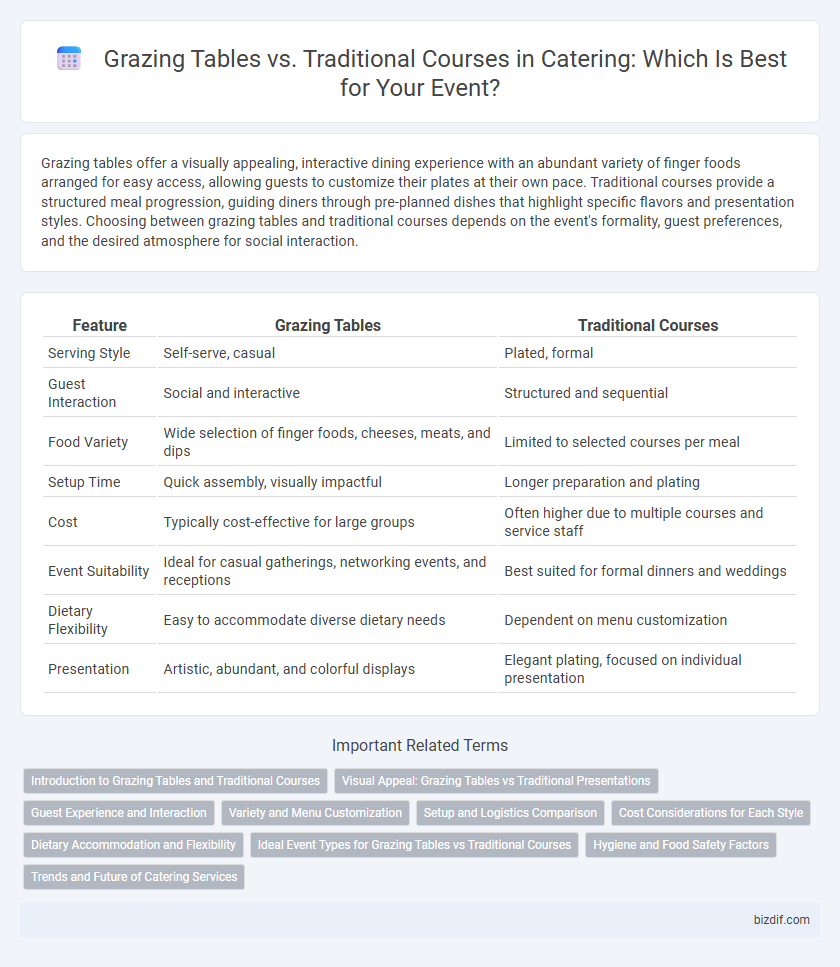Grazing tables offer a visually appealing, interactive dining experience with an abundant variety of finger foods arranged for easy access, allowing guests to customize their plates at their own pace. Traditional courses provide a structured meal progression, guiding diners through pre-planned dishes that highlight specific flavors and presentation styles. Choosing between grazing tables and traditional courses depends on the event's formality, guest preferences, and the desired atmosphere for social interaction.
Table of Comparison
| Feature | Grazing Tables | Traditional Courses |
|---|---|---|
| Serving Style | Self-serve, casual | Plated, formal |
| Guest Interaction | Social and interactive | Structured and sequential |
| Food Variety | Wide selection of finger foods, cheeses, meats, and dips | Limited to selected courses per meal |
| Setup Time | Quick assembly, visually impactful | Longer preparation and plating |
| Cost | Typically cost-effective for large groups | Often higher due to multiple courses and service staff |
| Event Suitability | Ideal for casual gatherings, networking events, and receptions | Best suited for formal dinners and weddings |
| Dietary Flexibility | Easy to accommodate diverse dietary needs | Dependent on menu customization |
| Presentation | Artistic, abundant, and colorful displays | Elegant plating, focused on individual presentation |
Introduction to Grazing Tables and Traditional Courses
Grazing tables offer a visually appealing and interactive dining experience featuring a variety of bite-sized, artisanal foods arranged for self-service, promoting social engagement and flexibility. Traditional courses follow a structured multi-course format, providing a carefully curated sequence of dishes served individually to guests, emphasizing formality and pace. Both styles cater to different event atmospheres, with grazing tables excelling in casual, communal settings and traditional courses suited for formal occasions.
Visual Appeal: Grazing Tables vs Traditional Presentations
Grazing tables offer a visually stunning and abundant display with colorful, artfully arranged assortments of cheeses, charcuterie, fruits, and vegetables that create an inviting and interactive experience. Traditional courses emphasize plated presentation with structured arrangement and portion control, focusing on elegance and refinement in each dish. The dynamic and expansive layout of grazing tables enhances guest engagement through aesthetic variety, contrasting with the formal and deliberate visual appeal of traditional multi-course meals.
Guest Experience and Interaction
Grazing tables create an interactive and communal dining experience, encouraging guests to explore a variety of flavors at their own pace, enhancing social engagement. Unlike traditional courses, which follow a structured sequence and limit guest interaction, grazing tables offer continuous access to diverse bites, fostering a relaxed atmosphere. This format elevates guest satisfaction by combining visual appeal with personalized tasting opportunities.
Variety and Menu Customization
Grazing tables offer unparalleled variety by featuring an abundant array of cheeses, charcuterie, fruits, nuts, and artisanal bread, allowing guests to sample multiple flavors and textures at their leisure. Traditional courses follow a structured sequence with limited customization per dish, often restricting guests to a single flavor profile at a time. Catering services benefit from grazing tables by providing dynamic, customizable menus that accommodate diverse dietary preferences and enhance the overall dining experience.
Setup and Logistics Comparison
Grazing tables require minimal staff and flexible space due to their self-serve nature, reducing setup time compared to traditional plated courses that demand coordinated timing and multiple servers. Logistics for grazing tables involve arranging a visually appealing spread with diverse items, emphasizing accessibility and refill efficiency rather than precise portion control. Traditional courses rely heavily on structured kitchen-to-table coordination and synchronized service flow, increasing complexity in both staffing and timing management.
Cost Considerations for Each Style
Grazing tables typically require a higher upfront cost due to the variety and volume of specialty ingredients, but can reduce expenses on staffing and service compared to traditional courses. Traditional multi-course meals often involve more extensive labor, kitchen time, and plated presentations, which can increase overall catering expenses. Cost efficiency depends on guest count, menu complexity, and desired presentation style, making budget alignment crucial for either catering approach.
Dietary Accommodation and Flexibility
Grazing tables offer superior dietary accommodation by presenting diverse, individually portioned options that cater to various dietary restrictions, including gluten-free, vegan, and nut-free choices, enhancing guest inclusivity. Traditional courses often have limited flexibility due to fixed menus, making it challenging to adjust dishes for specific allergies or preferences without extensive customization. The open-layout nature of grazing tables allows guests to select items that meet their dietary needs at their own pace, promoting a more personalized and adaptable dining experience.
Ideal Event Types for Grazing Tables vs Traditional Courses
Grazing tables are ideal for informal gatherings such as cocktail parties, corporate mixers, and networking events where guests prefer casual mingling and self-service options. Traditional courses better suit formal occasions like weddings, gala dinners, and award ceremonies that demand structured dining experiences and plated service. Event planners often choose grazing tables for interactive events and traditional courses for celebrations emphasizing elegance and ceremony.
Hygiene and Food Safety Factors
Grazing tables require meticulous attention to hygiene and food safety due to prolonged exposure of food items at room temperature, increasing the risk of contamination and bacterial growth. Traditional courses typically involve plated servings prepared and served promptly, reducing the risk associated with food exposure time. Proper temperature control, frequent replenishment, and protective coverings are essential for grazing tables to maintain sanitary standards and ensure guest safety.
Trends and Future of Catering Services
Grazing tables have surged in popularity as a modern catering trend, emphasizing visually appealing, customizable displays that encourage social interaction and flexible dining experiences. Unlike traditional courses, grazing tables offer variety and convenience, aligning with contemporary demands for experiential and Instagram-worthy events. Future catering services are likely to integrate more interactive and sustainable grazing concepts, responding to evolving client preferences for personalization and eco-conscious choices.
Grazing Tables vs Traditional Courses Infographic

 bizdif.com
bizdif.com